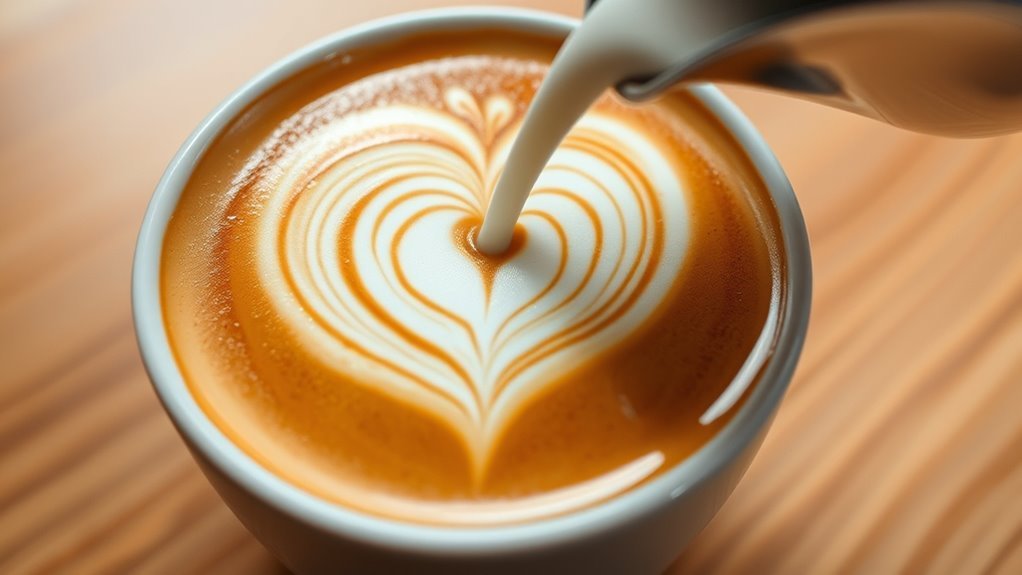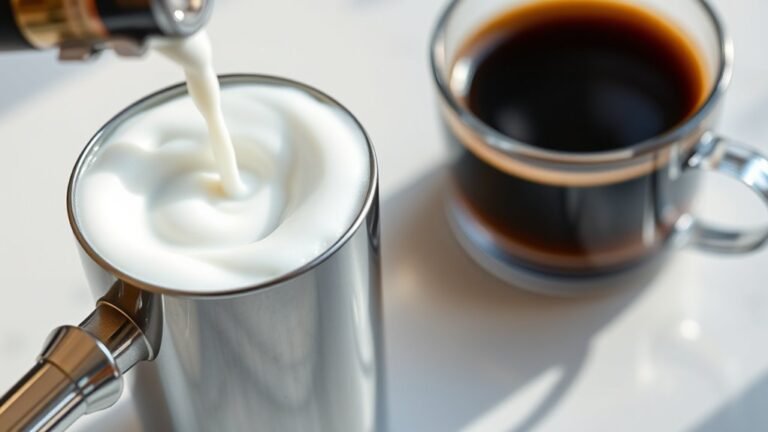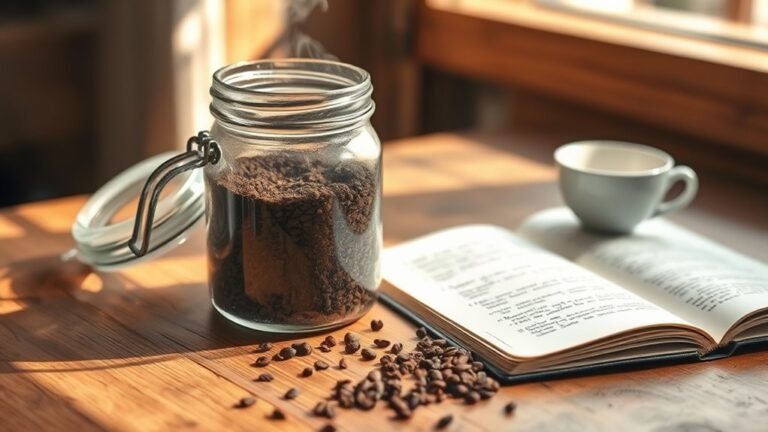Latte Art for Beginners: How to Pour a Heart
To pour a heart in latte art, start with a balanced espresso shot and smooth, velvety microfoam steamed between 140°F and 155°F. Hold your cup at a slight angle and pour steadily from a moderate height. As the cup fills, bring the pitcher closer and gently move your wrist to create the heart shape. Finish by pulling the stream straight through for the pointed bottom. With practice, you’ll gain control and confidence—there’s plenty more to explore in perfecting your technique.
What You Need to Get Started

Before you plunge into creating beautiful latte art, you’ll need a few essential tools to set yourself up for success. Your latte essentials start with a reliable espresso machine capable of pulling a smooth shot. Next, grab a stainless steel milk frothing pitcher—the shape and spout design are vital for controlled pouring. A thermometer helps you monitor milk temperature, ensuring perfect microfoam without overheating. Don’t forget a sturdy tamper to evenly press your coffee grounds. Your equipment checklist should also include a quality grinder to achieve consistent espresso extraction. With these basics, you’ll have the freedom to practice and perfect your technique confidently. Having the right tools empowers you to express creativity and enjoy the rewarding process of latte art.
Choosing the Right Coffee and Milk
With the right tools in hand, the next step is selecting coffee and milk that work harmoniously to create your latte art. Choosing the right coffee variety affects flavor depth, while the milk type influences texture and froth quality. For beginners, a medium roast coffee is a reliable choice, offering balance and sweetness. As for milk, whole milk creates a creamy microfoam perfect for pouring hearts, but if you prefer alternatives, oat milk steams well and froths nicely.
| Coffee Variety | Flavor Profile | Best For |
|---|---|---|
| Medium Roast | Balanced, Sweet | Beginners |
| Dark Roast | Bold, Bitter | Intense Flavor |
| Single Origin | Unique, Complex | Exploration |
| Milk Type | Frothing Ease | Texture |
| Whole Milk | Easy | Creamy, Smooth |
| Oat Milk | Moderate | Velvety |
| Almond Milk | Challenging | Light, Airy |
Preparing the Espresso Shot
To create great latte art, you’ll first need a well-prepared espresso shot, starting with choosing the right coffee beans that suit your taste. Focus on getting a balanced extraction—too fast or too slow can affect flavor and crema quality. With practice, you’ll nail the perfect shot that forms a solid foundation for your art.
Choosing Coffee Beans
Selecting the right coffee beans is the foundation for a great espresso shot, which in turn is essential for beautiful latte art. When choosing coffee bean varieties, consider how their unique flavor profiles will influence your final cup. Arabica beans offer a smooth, sweet taste with hints of fruit or chocolate, perfect for balanced, creamy latte art. Robustas, on the other hand, pack a stronger, more bitter punch with earthy undertones, which might overpower delicate milk textures. Don’t hesitate to experiment with single-origin beans to explore diverse flavor notes that inspire your creativity. Remember, freshness matters—opt for recently roasted beans to reveal vibrant aromas and richer crema. By selecting beans thoughtfully, you’re setting yourself free to craft espresso shots that not only taste amazing but also pour beautifully.
Optimal Espresso Extraction
Although choosing quality beans is essential, how you extract your espresso shot truly determines the foundation of your latte art. Start by dialing in your espresso grind: it should be fine but not too powdery, allowing water to flow evenly during extraction. If the grind’s too coarse, your shot will be weak; too fine, and it’ll be bitter. Pay close attention to shot timing—aim for about 25-30 seconds to pull a balanced 1 to 1.5-ounce shot. This timing guarantees ideal flavor and body, giving you a creamy base for your steamed milk. Remember, mastering espresso extraction is about experimenting and trusting your senses. Once you get this right, you’re free to create beautiful heart-shaped latte art with confidence.
Steaming Milk to the Perfect Texture
To create beautiful latte art, you’ll need to steam your milk to the right temperature and texture. Focus on achieving smooth, velvety microfoam by mastering proper steaming techniques and keeping your milk between 140°F and 155°F. With a bit of practice, you’ll learn how to control the milk’s consistency for that perfect pour every time.
Milk Temperature Guidelines
When you’re steaming milk for latte art, getting the temperature right is crucial because it directly affects both the texture and taste. Aim for a range between 140°F and 155°F (60°C to 68°C). This sweet spot guarantees your milk frothing creates the silky, creamy base needed for beautiful latte art without scalding the milk, which can ruin flavor and texture. Use a thermometer or develop a feel for temperature control by touch—warmed but not too hot to hold. Mastering this balance gives you freedom to craft smooth, rich milk that complements your espresso perfectly. Remember, precision in temperature control is your foundation for consistent, high-quality pours that allow your latte art to shine.
Achieving Microfoam Consistency
Even if you’ve nailed the milk temperature, achieving the perfect microfoam requires mastering how you introduce air and texture during steaming. Understanding microfoam science helps you create tiny, uniform bubbles that improve foam stability and give your latte art that smooth, velvety finish. You want that milk to feel silky and pour effortlessly.
| Step | What to Focus On |
|---|---|
| Introduce air | Start with the steam wand just below the surface |
| Texture milk | Lower pitcher to incorporate air evenly |
| Monitor temperature | Aim for 55-65°C for ideal texture |
| Check foam | Look for shiny, paint-like foam |
| Finish steaming | Tap and swirl to blend milk and foam |
Master these, and you’ll gain freedom in your latte art journey.
Steaming Techniques and Tips
Mastering three key steaming techniques can transform your milk into the perfect canvas for latte art. First, focus on controlling the steaming temperature; aim for 140–150°F to create smooth, velvety microfoam without overheating. Second, position the steam wand just below the milk’s surface to introduce air gently, then submerge it deeper to heat evenly. Third, consider the milk types you use—whole milk produces creamier textures, while alternatives like oat or almond require slight adjustments in steaming time and temperature. Remember, each milk type behaves differently, so experiment to find what suits your style. With practice, these steaming tips will give you freedom to craft beautiful hearts, letting your creativity flow effortlessly with every cup you pour.
Basic Pouring Techniques for Latte Art

Although pouring may seem simple, it’s actually the foundation of creating beautiful latte art. Understanding basic pouring techniques connects you to the rich latte art history, where every skilled barista mastered control and flow. Start by holding your cup at a slight angle and pour steadily from a moderate height to integrate milk with espresso smoothly. As you get closer to the surface, lower the pitcher to influence the pouring aesthetics, allowing the milk foam to form distinct patterns. Your wrist movement and pouring speed directly shape the design’s clarity and symmetry. Remember, freedom in latte art comes from mastering these basics, enabling you to express creativity confidently. Practice patience; your steady hand will soon craft elegant and consistent hearts.
Step-by-Step Guide to Pouring a Heart
Now that you’ve got a handle on basic pouring techniques, it’s time to put them into practice by creating a classic heart shape. Start by pouring steamed milk steadily into the center of your espresso. As the cup fills, gently move the pitcher closer to the surface to allow the foam to rise. When the cup is nearly full, give a slight wiggle to spread the foam evenly, then swiftly pull the pitcher away in a straight line to form the heart’s point. Mastering these heart design techniques opens the door to more complex latte art styles, giving you freedom to express creativity with each cup. Keep practicing this step-by-step guide, and you’ll soon pour hearts with confidence and ease.
Tips to Improve Your Latte Art Skills
Once you’ve nailed the basics of pouring a heart, improving your latte art skills comes down to refining your technique and developing your own rhythm. Start by incorporating focused practice exercises, like pouring slow, controlled streams and varying your pitcher height. These drills help you master milk texture and flow, essential for crisp designs. Watch out for common mistakes such as pouring too fast, which breaks the milk’s surface, or using milk that’s too hot, affecting consistency. Don’t get discouraged; each pour teaches you something new. Experiment with different milk types and pitcher shapes to find what feels natural. Remember, freedom in latte art comes from confidence and control, so keep practicing deliberately, and you’ll soon create hearts that are both beautiful and uniquely yours.
Frequently Asked Questions
Can I Use Non-Dairy Milk for Latte Art?
You can definitely use non dairy options for milk frothing and creating latte art. It might take a bit of practice since plant-based milks like oat, almond, or soy froth differently than dairy. Look for barista blends designed for frothing—they tend to have better texture and stability. Don’t be discouraged if your first tries aren’t perfect; with patience, you’ll master pouring beautiful designs while enjoying your favorite milk alternative. Keep experimenting!
How Do I Clean My Steaming Wand Properly?
Oh sure, just let your steaming wand soak in old milk forever—that’s the steaming technique no one recommends! To keep your wand spotless, wipe it immediately after steaming, purge it by releasing steam briefly, then soak the tip in warm water if needed. Different milk types, especially non-dairy, can leave residues, so consistent cleaning is key. Doing this frees you from buildup and guarantees every pour is smooth and flawless. You’ve got this!
What Equipment Brands Are Best for Beginners?
When you’re starting out, choosing reliable espresso machines and milk frothers is key. Brands like Breville and De’Longhi offer beginner-friendly espresso machines with intuitive controls, letting you explore freedom in brewing. For milk frothers, Nespresso and Aerolatte provide great options that simplify frothing without sacrificing quality. These brands balance ease of use with performance, so you can focus on perfecting your coffee skills and enjoying every cup you create.
How Long Does It Take to Master Latte Art?
Mastering latte art techniques really depends on you and how often you practice consistency. If you dedicate time daily, you could see solid progress in a few weeks, but true mastery might take months. Don’t rush it—enjoy the freedom to experiment with your style and flow. Remember, every cup is a chance to improve. Stay patient and keep pouring; your skills will grow naturally with steady practice.
Can Latte Art Affect the Taste of Coffee?
You might not realize it, but latte art can subtly influence your taste perception. While it doesn’t change the coffee’s flavor, the visual appeal heightens your overall experience, making each sip feel richer and more enjoyable. When you pour a beautiful design, your brain anticipates something special, which can enhance how you perceive taste. So, don’t just focus on flavor—embrace the art to free your senses and savor every cup.






